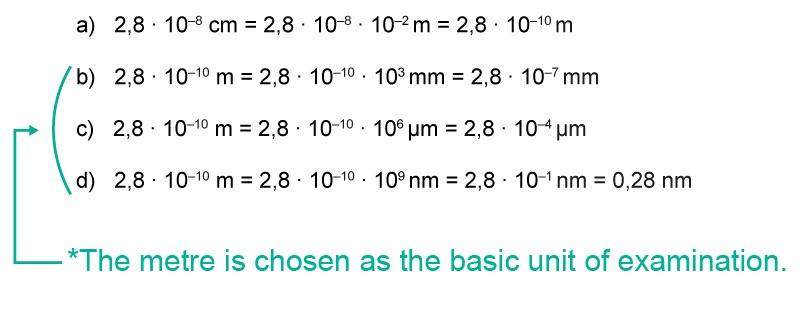Names and signs
Some of the bigger numbers have their own names:
There are also commonly used multiplier unit prefixes for some units. One of the best known prefixes is kilo [[$ (10^3) $]]. Common prefixes are often used instead of scientific expression forms. For example, it is preferable to describe a mass as being 23 kg rather than [[$ \text{2,3} \cdot 10^4 $]] g, or a distance as being 17 km rather than [[$ \text{1,7} \cdot 10^4 $]] m.
b) millimetres
c) micrometres and
d) nanometres.
Solution:

* The metre is chosen as the basic unit of examination. Note that the coefficients of the scientific expressions transform the numerical values into metres (mm = 10-3 m) and that we now want to complete the conversions in the other direction.
| Name | Number of zeros |
|---|---|
| million | 6 |
| billion | 9 |
| trillion | 12 |
| quintillion | 18 |
| septillion | 24 |
| nonillion | 30 |
| undecillion | 36 |
| tredicillion | 42 |
| googol | 100 |
| Name | Symbol | Base 10 |
|---|---|---|
| giga | G | [[$ 10^9 $]] |
| mega | M | [[$ 10^6 $]] |
| kilo | k | [[$ 10^3 $]] |
| hecto | h | [[$ 10^2 $]] |
| deca | da | [[$ 10^1 $]] |
| deci | d | [[$ 10^{-1} $]] |
| centi | c | [[$ 10^{-2} $]] |
| milli | m | [[$ 10^{-3} $]] |
| micro | μ | [[$ 10^{-6} $]] |
Example 3
The diameter of a water molecule is [[$\text{2,8} \cdot 10^{-8}$]] cm. Express the diameter in
a) metresb) millimetres
c) micrometres and
d) nanometres.
Solution:

* The metre is chosen as the basic unit of examination. Note that the coefficients of the scientific expressions transform the numerical values into metres (mm = 10-3 m) and that we now want to complete the conversions in the other direction.